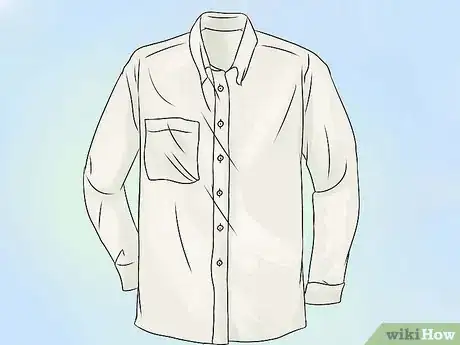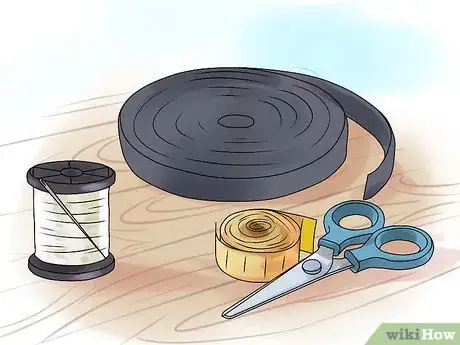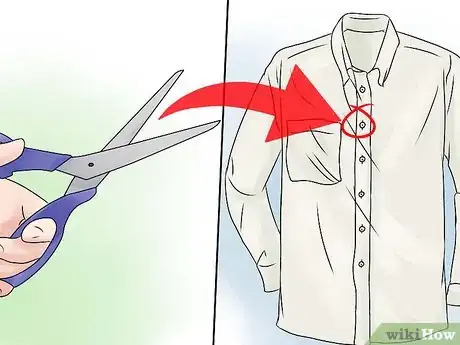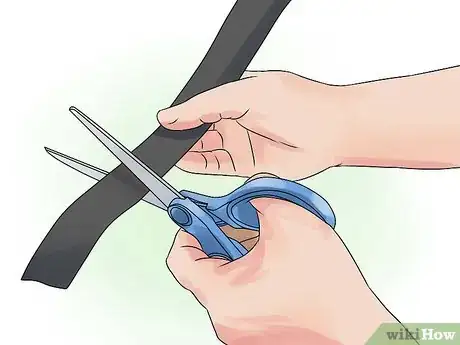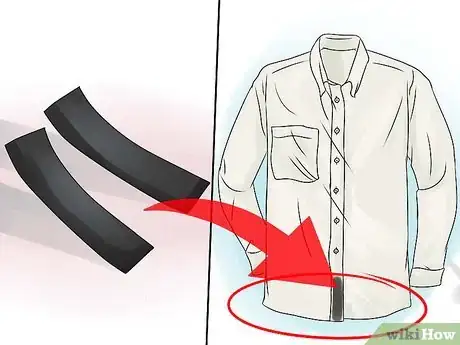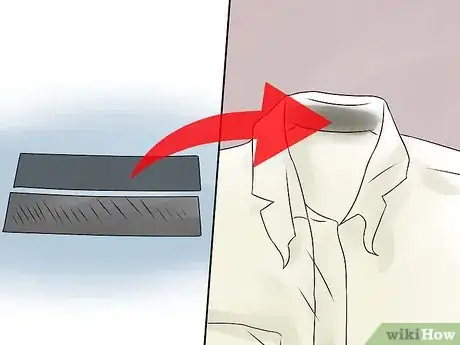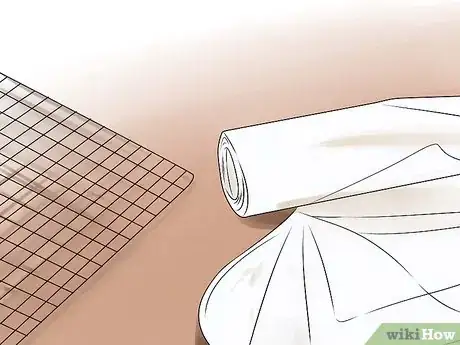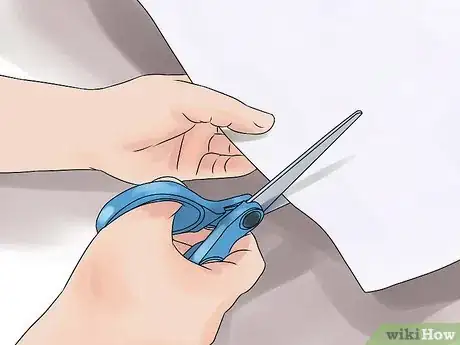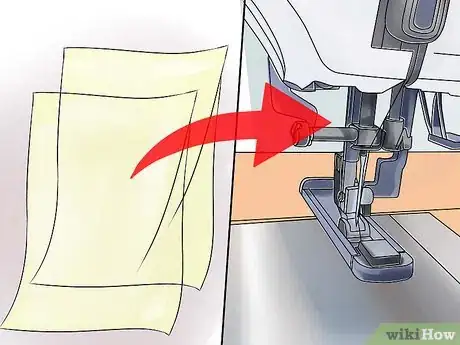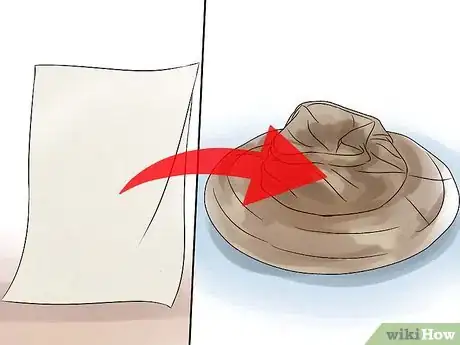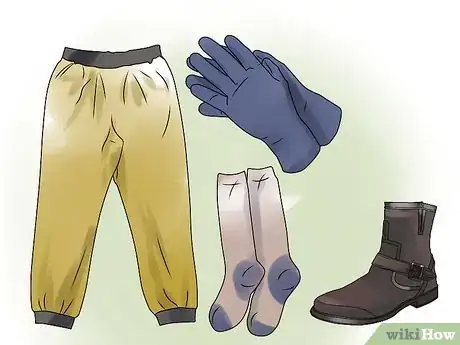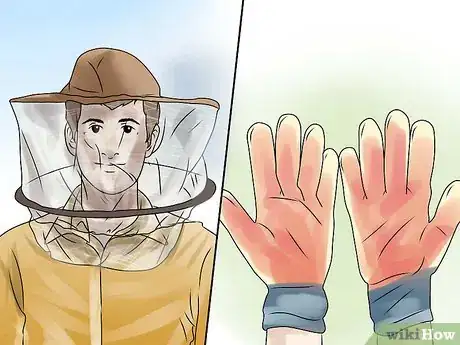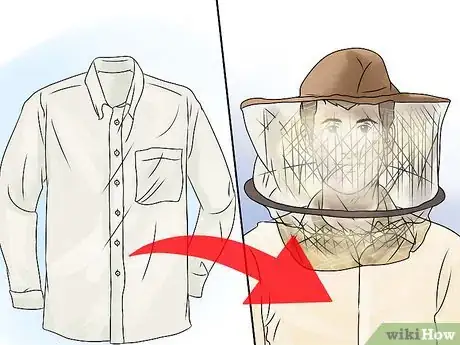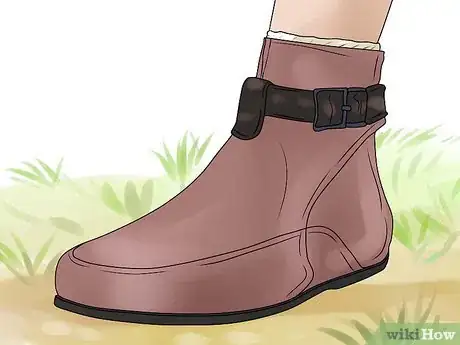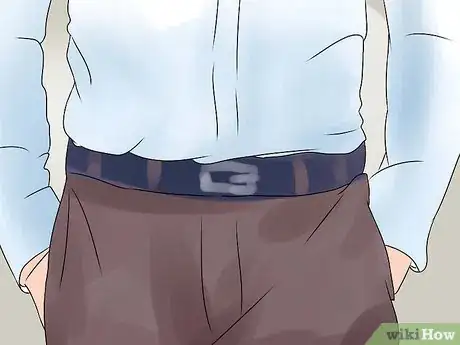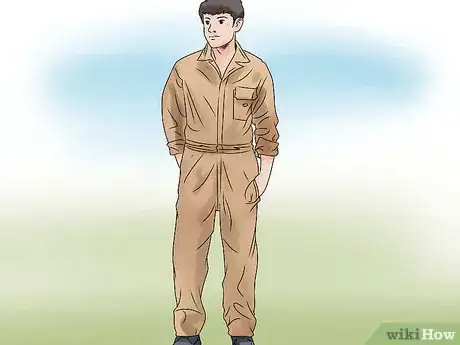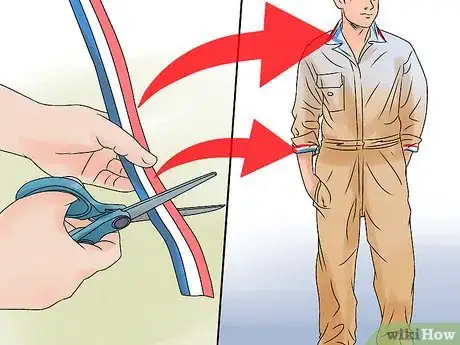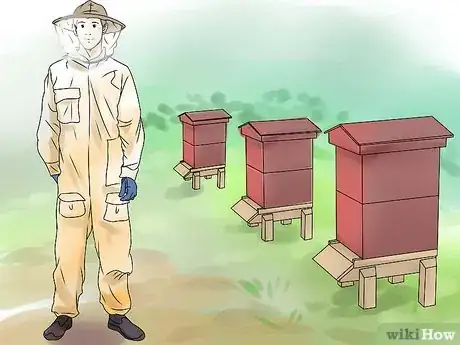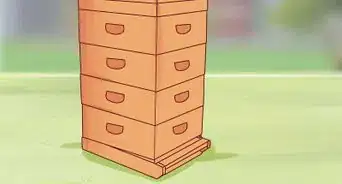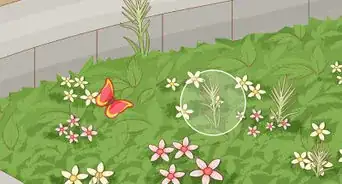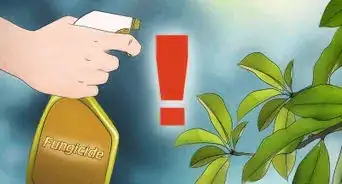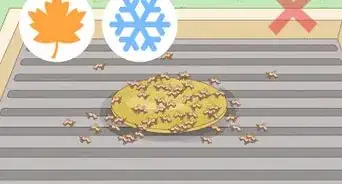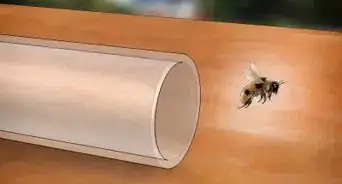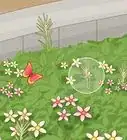This article was co-authored by David Williams. David Williams is a Professional Beekeeper and Bee Removal Specialist with over 28 years of beekeeping experience. He is the Owner of Bzz Bee Removal, a bee removal company based in the San Francisco Bay Area. Bzz Bee Removal locates, captures, and transports bees to local beekeepers to prevent colony collapse disorder.
wikiHow marks an article as reader-approved once it receives enough positive feedback. In this case, 95% of readers who voted found the article helpful, earning it our reader-approved status.
This article has been viewed 130,721 times.
A beekeeper's suit is one of the most important tools a beekeeper can have. It protects against the stings and can greatly reduce the beekeeper's anxiety when the bees get agitated. A beekeeping suit includes a long-sleeved body covering, a hat with a veil, and gloves and boots to keep out the bees.
Steps
Making the Shirt
-
1Choose a white button-down shirt. When it comes to making a beekeeping suit, the shirt is the trickiest part. It's helpful to have a shirt that opens in the front so you can fasten it securely around your veil, but you will need to alter it so bees can't crawl into the holes between the buttons. Look for a shirt with the following qualities:[1]
- The fabric is thick; look for a heavy cotton or denim.
- The color is white or another very light color. Bees feel threatened by darker colors, which remind them of bears.
- The fit is loose. Choose a size or two larger than what you normally wear, rather than getting a shirt that's skin tight. That way if a bee inserts its stinger into the fabric, it won't be right against your skin.
-
2Gather other supplies. You'll need to make a few alterations along the collar, sleeves and opening in order to create a tight seal that will keep bees from crawling in. It helps to have a sewing machine, but if you don't have one, you can certainly make the alterations by hand. Here's what you need:[2]
- A roll of one-inch wide white velcro. Stick-on velcro works fine, or you can get the type that doesn't have adhesive backing. You need enough to line the shirt opening, the collar and the sleeve openings, so you may want to take measurements before purchasing velcro.
- A needle and white thread (or a sewing machine, if you have one).
- A measuring tape and scissors.
Advertisement -
3Remove the buttons from the shirt. Use a small pair of scissors to snip off all the buttons. Take care to snip the threads just underneath the buttons without cutting a hole in the shirt. Snip the buttons from the opening of the shirt, the collar and the sleeve openings.[3]
-
4Sew the button holes closed. Thread your needle and tie a knot at the end of the thread. Insert the needle from inside the shirt near the edge of a buttonhole. Stitch the buttonhole tightly closed, then finish it off by tying another tight knot. Repeat until you've sewn every buttonhole closed, including those around the collar and sleeve openings.
- You might want to double-thread the needle if you're working with thin or weak thread.
- Neat, invisible stitching is not the goal: just make sure the buttonholes are tightly closed and won't pop open when you're handling bees.
-
5Cut velcro to line the shirt opening. Measure the length of the shirt opening. Place the measuring tape along the edge of the shirt's opening. Measure the length of the opening from the tip of the shirttail to the bottom of the collar. Write down the measurement, then use it to cut two pieces of velcro that will stretch the entire length of the shirt opening on both sides.
-
6Attach the velcro to the shirt opening. Remove the adhesive backing from the velcro pieces. Sew a piece of velcro over the length of the opening where you cut off the buttons. Sew another piece of velcro along the underside of the opening where you sewed up the buttonholes. The two pieces of velcro should seal firmly together when you close the shirt.
- If you have a sewing machine, you can quickly sew down the velcro strips to secure them in place. Stitch the entire length of the velcro to hold it down. You can stitch along the edges of the velcro or make one long stitch down the middle.
- If you're sewing by hand, make tight, neat stitches so that the velcro does not come loose while you're wearing your bee suit.
-
7Cut and attach velcro around the collar and sleeves. Use the measuring tape to measure around the collar. Cut a length of velcro according to your measurement, and sew it around the inside of the collar. Cut a second length and sew it around the outside of the collar. This will allow you to adjust the collar to make it tight enough to keep bees out. Use the same method to add velcro to the sleeve openings.
- Again, a sewing machine makes it easy to quickly sew down the velcro strips to secure them in place. Stitch the entire length of the velcro to hold it down. You can stitch along the edges of the velcro or make one long stitch down the middle.
- If you're sewing by hand, make tight, neat stitches so that the velcro does not come loose while you're wearing your bee suit.
EXPERT TIPDavid Williams is a Professional Beekeeper and Bee Removal Specialist with over 28 years of beekeeping experience. He is the Owner of Bzz Bee Removal, a bee removal company based in the San Francisco Bay Area. Bzz Bee Removal locates, captures, and transports bees to local beekeepers to prevent colony collapse disorder.Beekeeper & Bee Removal Specialist
 David Williams
David Williams
Beekeeper & Bee Removal SpecialistExpert Trick: To make a bee suit on a budget, purchase ripstop nylon and a sewing pattern for a jumpsuit with a hood. Then, just cut the pattern out of the nylon and sew it together yourself.
Making the Hat and Veil
-
1Choose a wide-brimmed hat. A cowboy-style hat with a wide brim makes the perfect base for your beekeeping hat. It will keep the veil from touching your face as you work, making it easier to see and less likely that a bee will get close enough to your skin to sting. Look for a hat with these qualities:[4]
- The fabric is thick enough to keep out bees, but thin enough to pierce with a sewing needle. Felt and tightly-woven straw hats work well; leather can be too thick.
- The hat is lightweight enough that you won't overheat. You'll be doing most of your beekeeping in the summer, so keep that in mind when you choose your hate.
- The brim is stiff, not floppy. It should be firm enough to keep the veil several inches from your face.
-
2Gather supplies to make the veil. You can use stiff nylon mesh, tulle, or wire mesh to make the veil. You need enough veil fabric to fit around the brim of the hat and fall at least five inches below your shoulders. One yard should be sufficient.
- Be sure to use a clear or white fabric so that you'll be able to see through it easily.
- If you find a thin tulle you want to use, you may need a double layer to make sure your veil keeps the bees away.
-
3Measure and cut the fabric. Measure around the brim of the hat, then cut your fabric about an inch wider. You'll need a bit of overlap to make sure the bees can't get through the seam. Make sure the fabric is long enough to drape down five inches below your shoulders.
-
4Bring the edges together and sew the seam. Overlap the edges by half an inch. Stitch the edges closed to create a large tube of fabric with the same circumference as your hat's brim. Make sure the tube is sturdy enough to keep out bees before moving to the next step. It doesn't hurt to add an extra row of stitches along the seam.
-
5Sew the veil to the brim of the hat. Working by hand, carefully sew the top edge of the veil around the brim of the hat. If you are hand-sewing, be sure to use small whip-stitches to keep all openings too small for the bees to enter and get underneath the mesh. Continue until the veil is tightly secured to the hat.
Finishing the Suit
-
1Buy the remaining beekeeping suit essentials. Your bee-tight shirt and hat are the most important parts, but in order for your suit to work, you'll need a few more items. Remember that everything should be white or light in color:[5]
- Thick white sweatpants or work pants. Make sure they have tight elastic around the waist and ankles. You can also wear white workout pants if sweatpants are too hot.
- Tall socks.
- Thick gloves. Dishwashing gloves work just fine. Some beekeepers prefer to be bare-handed.
- Sturdy work boots. Look for boots that are ankle or calf length and made of leather or other durable material. There should be enough room around the opening of the boot so you can tuck the bottom of the pants into them.
-
2Put on the hat and gloves. Set the hat on your head and drape the veil down over your shoulders, bunching it around your neck. Pull up the gloves so that they cover your hands and wrists.
-
3Put on the shirt. Put it on so that the end of the veil is tucked under the shirt. Secure the shirt opening by pressing the velcro closed. Secure the velcro around the collar and sleeve openings. Check to make sure there are no gaps.
-
4Tuck the shirt into your pants. Make sure the elastic on your pants is tight around the bottom of your shirt.
-
5Put on your socks and shoes. Pull the elastic at the bottom of your pants over your socks. Put on your shoes, and tuck the bottom of your pants into your shoes before tying them. You are now ready to handle bees.
Converting Coveralls
-
1Purchase a light-colored, long-sleeved coverall. This option is more expensive than making a suit out of a shirt and pants, but some find it easier to have a one-piece suit. make sure the coverall you purchase is white or light in color.
- Dark colors can aggravate bees since these colors remind them of their predators, like bears and skunks.
- Make sure the coverall fits loosely in order to keep the material from directly contacting the skin. This helps to avoid stingers that might pierce the fabric.
-
2Attach elastic to the neck hole and wrists. Measure elastic to fit the neck hole and wrists, then cut the elastic to the correct measurements. Sew the elastic pieces around neck opening and wrist openings.
- This is important to prevent bees from gaining access to the inside of the coverall.
- Don't make the elastic too tight, but it should be tight enough to offer protection from bees.
-
3Put on your suit. When putting on the beekeeper's suit, put the hat on first, then the coveralls. Make sure the mesh of the hat is securely tucked in at the neck of the coveralls. Add gloves, socks and boots to the ensemble.
Community Q&A
-
QuestionHow do I find a queen bee in the wild?
 Community AnswerQueen bees only leave the hive to mate (only once) or when they depart to find a new home with thousands of other bees in a swarm. The rest of their lives, queens live inside the hive. So, there is really no finding a queen in the wild.
Community AnswerQueen bees only leave the hive to mate (only once) or when they depart to find a new home with thousands of other bees in a swarm. The rest of their lives, queens live inside the hive. So, there is really no finding a queen in the wild.
Warnings
- Wash the suit after each use. Bees release strong pheromones when they sting that attracts and excites the hive into further attacks, so you want to avoid this as much as possible. These pheromones will remain on the suit if you don't wash it.⧼thumbs_response⧽
- Be aware of your own sensitivity and reactions to bee stings. Many people are allergic to them. A beekeepers suit will provide you with protection from bees, but being stung is a hazard of keeping bees.⧼thumbs_response⧽
- Many bee-specific suits may not work for other insects or animals, so don't think you have protection from them when you have this on.⧼thumbs_response⧽
Things You'll Need
Two-Piece Suit
- A large white button-down shirt
- Roll of velcro
- Tape measure
- Needle and thread or sewing machine
- White sweatpants with elastic waist and ankles
- Gloves
- Boots
Coverall Suit
- A white or light-colored pair of long sleeve coveralls
- 2 feet (0.6 meters) of 1/2 inch (12.5 mm) elastic
- Tape measure
- Needle and thread or sewing machine
- Ankle or shin work boots
Hat
- Wide-brimmed hat
- Yard (0.45 meter) of mesh or netting
References
- ↑ http://www.buzzaboutbees.net/beekeeping-basics.html
- ↑ http://www.buzzaboutbees.net/beekeeping-basics.html
- ↑ https://diy.org/skills/beekeeper/challenges/596/make-a-beekeeping-suit
- ↑ http://keepingbee.org/bee-veil/
- ↑ https://books.google.com/books?id=ZLLB2fh55aQC&pg=PA31&lpg=PA31&dq=make+a+beekeeping+suit+out+of+coveralls&source=bl&ots=UUqBceEzs-&sig=GLRV__7tUIOhz6pOz-2ZbkmkkXU&hl=en&sa=X&ei=kEQDVc6QF4KwggTx9YPoCg&ved=0CDUQ6AEwAw#v=onepage&q=make%20a%20beekeeping%20suit%20out%20of%20coveralls&f=false
